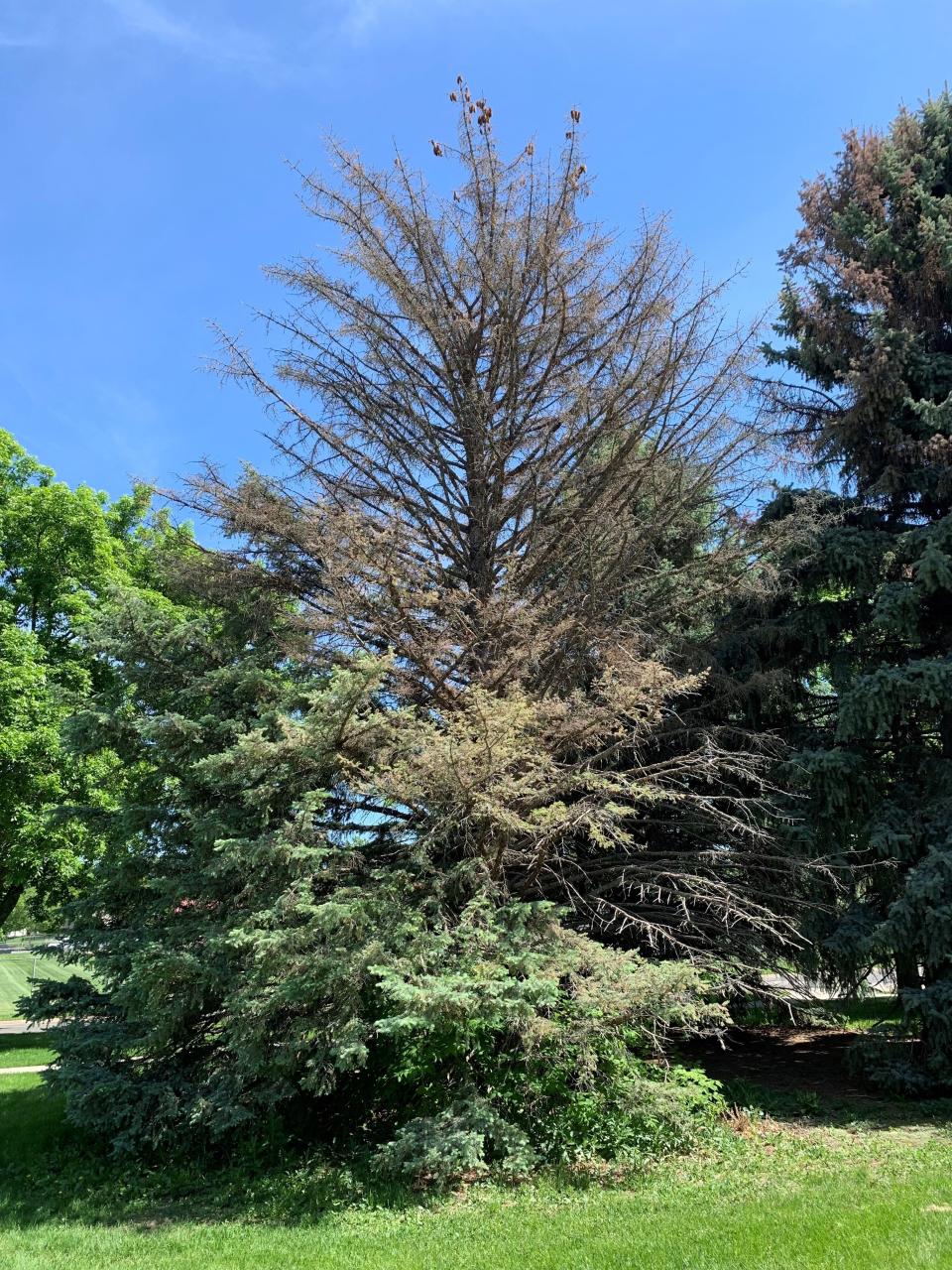Move over, emerald ash borer. There's another insect killing Fort Collins trees
You would think with all the rain we had this spring your trees would look healthy.
Most do, but some trees in Fort Collins are dying — and it's not the emerald ash borer killing them.
There's another tree killer in town, impacting blue and Black Hills spruce trees.
Ralph Zentz, city of Fort Collins assistant forester, said spruce trees are suffering from the spruce ips hunteri beetle, a native beetle found in the mountains that began invading the city a couple years ago.
Zentz said the city is seeing the second big wave of the ips beetle in the last 40 years, resulting in the city identifying about 200 infected spruce trees.
Why are spruce trees dying now despite all the moisture we had this spring?
Zentz said drought, especially in 2021 when the city saw scant moisture August through the end of December, set the stage for the beetles to invade.
He said a windy and dry summer and fall in 2021, coupled with people shutting off irrigation systems and not watering their spruce trees over the winter, allowed the insects to attack the stressed trees.
"The No. 1 defense to protect your spruce trees from the insect is water,'' he said.
Zentz said this spring's ample moisture will help spruce trees. He said properly watered spruces have the ability to use sap to push the beetles attacking the tree out when they tunnel into the bark. Tunneling prevents the tree from taking in water.

How do I know if my spruce is infected with the beetles?
Zentz said the most common clue is the spruce tree dying at the top of the tree then the dying continues down the tree. Once the top of a tree shows symptoms, it usually is too late to save the tree.
"The tree is dead but doesn't know it,'' he said.
Ips beetles are 1/8 to 3/8 inch long and are reddish-brown to black in color.
Are there treatments to save my spruce tree once infected?
Zentz said injections of insecticides have been used on infected trees but are largely ineffective. Another option is using preventative sprays on valued trees.
Either way, he said treatments should be done by a certified arborist because of the chemicals used and application process.
Why pruning your spruce could attract the ips beetle
Pruning your spruce tree sends out a signal that attracts insects such as beetles to the fresh wound. If you prune spruce trees, it is best done in winter.
Why you shouldn't bring wood from the mountains to the city
Zentz said the beetles traveled from the mountains in cut firewood to Fort Collins, which is why any wood in the mountains should not be brought back to town.
Also, any infected trees in the city should be removed and the wood can't be used for firewood, he said.
Options of disposal include immediately chipping the wood, recycling at Ewing Landscape Materials, removing and disposing of all bark or taking it to the landfill for proper disposal.
What is the latest on the emerald ash borer in Fort Collins?
Zentz said the emerald ash borer was first discovered in the area in a mobile home park near Colorado Highway 1 and U.S. Highway 287 in May 2020. It is believed the borer was introduced through firewood.
He said it doesn't appear the borer has spread much from the original area in Fort Collins.
He said the city has planted different varieties of trees near ash trees for future replacement if the ash are killed by the borer. He added the city has discontinued removing uninfected ash trees it's not going to treat.
"We decided (that a plan) to remove those trees preemptively wasn't a good plan and instead we should keep the benefits of the tree as long as we can,'' he said. "We have almost 3,000 open places on our list to plant trees, so to add to that didn't make sense.''
He said preventative measures can be taken to protect valued trees. Proper watering also aids in defense from the borer.
How much water does my tree need?
A rule of thumb for applying the proper amount of water is 10 gallons per inch of tree diameter. A one-inch tree will require 10 gallons of water each time it is watered. For mature trees — 10 inches in diameter or more — apply 15 gallons of water per inch of tree diameter. Use a ruler to measure your tree’s diameter.
Consistently water deeply and slowly. Apply water so it moistens the critical root zone from near the trunk of the tree to the dripline) to a depth of 12 inches. Mature trees in or near lawns will receive some water with lawn irrigation.
Generally, a newly planted tree should be watered every three to five days during the growing season, depending on weather and soil conditions. Remember that newly planted trees also need water during dry periods in the winter months. Try to water at least once a month in the dormant season.
Mulch, including leaving pine needles, helps retain moisture.
This article originally appeared on Fort Collins Coloradoan: Is your spruce tree is dying in Fort Collins? This might be why

